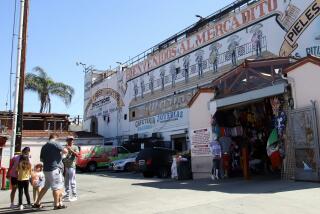Immigrant’s Story : Skill Opens the Land of Opportunity
- Share via
CHICAGO — Joe Ernst scanned a set of blueprints, put half a dozen steel ingots on a rotating metal table, flipped a switch to activate a magnet to tie them down, then twirled a set of dials to tell the machine how much metal its graphite grinding wheel should shear from the bars.
“Right now, it doesn’t look like much. It’s easy, right?” he said with a knowing smile. “But what happens when you want to take one-thousandth of an inch off? That’s thinner than your hair. That takes skill.”
Joe Ernst’s life is an exercise in precision.
He is a machinist, a member of Machinists Local 48 at the Grotnes Metal Forming Systems plant on Chicago’s North Side. To some, however, the 35-year-old Romanian immigrant might seem an artist who conducts a symphony in heavy metal. He cuts, shapes, bends, stretches, shrinks and expands pieces of metal to the precise tolerances needed to form them into the machines that make American industry run. Ernst helps to make the machines that make the machines.
Machinery of Industry
Machines to make rims for bicycles, golf carts and cars. Machines to make oil barrels. Machines to make oil pipelines. Machines to build jet engine parts. Machines to build nose cones for NASA rockets. Ernst has worked on them all.
“We build a damn good machine, a damn good machine,” he said, as he measured the trimmed ingots with his pocket micrometer. “Something that really stands up.”
These days, Ernst and his 26 co-workers at Grotnes are putting the finishing touches on an intricate system of ramps, presses, claws, hoists and welders--about the length of a basketball court when all put together--that will transform rolled steel into finished truck wheels at the rate of 1,000 an hour. They have been working on the system for a Michigan auto parts company for eight months.
It will be a highly automated assembly line, the kind of sophisticated, efficient process that American manufacturers say they must use to trim costs and beat back foreign competition. Ernst, who grew up behind the Iron Curtain, sees himself as a small cog in the resurgence of American industry.
“What we do is just a little part of things, but it’s important because of America’s future,” he said. “People are going to be able to buy cars or trucks with a little less money than if there was no company like this. Can you imagine how much it would cost if they had to shape these rims by hand? Without companies like this, you wouldn’t be able to drive a car. Instead of costing $10,000, they’d cost $30,000 . . . . If the U.S. did not have places like this, a lot of people would be a lot worse off.”
He knows. In his native Romania, Ernst says, even a used car can cost the equivalent of $30,000 or more. Ernst owns two cars, one a late-model German import. In Romania, he never could have earned or saved enough to buy one, let alone the town house in the city he bought in 1978 or the three-bedroom, split-level suburban house he moved into last month.
Ernst’s story is a familiar one in Chicago, where, for more than a century, brawny Eastern European immigrants have done the heavy lifting that earned this Midwestern industrial center the nickname “City of the Big Shoulders.” They came to work in the stockyards and meatpacking plants, then the steel mills, then the factories and freight yards, each wave of newcomers lured by tales of a better life heard from friends and relatives who had preceded them.
Joined Chicago Uncle
In Ernst’s case, the stories came from an uncle from Chicago who visited his family’s home in Timisoara, the industrial center of western Romanian near the Yugoslavian border. “He told us how much better it was over here,” Ernst recalled. “So we came.”
It was not quite that easy. It took Ernst and his parents 10 years of applications and waiting before they could obtain permission to leave Romania and enter the United States. He was a boy when they first applied, he was a young man of 21 when they departed.
In the interim, the state had sent him to trade school instead of high school and taught him to be a machinist. Before he was 18, Ernst was working in a state factory making parts for machines he presumed were being assembled in other state factories, although he rarely was told what machines the parts were for.
His training proved fortuitous, however. To his surprise, when he arrived in Chicago, he discovered that few American youngsters went to trade schools any more, and that skilled craftsmen were in short supply. Relatives had little trouble landing him a job with a friend who had a machine shop. His new employer spoke only English, “so I was forced to learn,” Ernst recalled.
Ernst quickly discovered another American phenomenon--the magic of credit. Within three months of his arrival, and for only $200 down, he bought the car he could only dream about back home--a $2,000 used Pontiac Firebird. A friend coached him in German to help him pass the driver’s test.
Met Future Wife
An even more important discovery came through family connections, after his father began working in the uncle’s paint shop.
“One of the ladies in the shop says there’s a girl from my village she knows,” Ernst remembered. “She gives me the address. She said she is alone and she doesn’t have too many friends. I wanted to see her just to see if I knew her.”
As it turned out, the two had never met, but that did not matter. Ernst and the girl, Anna, who had both come from Romania in 1970, were married in 1976. They have two boys, 5-year-old Christopher and 18-month-old Michael. Anna Ernst, 33, is a secretary with a telephone company.
The couple scrimped and saved and, by 1978, about the time Ernst hired on at Grotnes, were able to buy a town house in an ethnic neighborhood on the city’s northwest side.
“Right now, I’m trying to raise my kids to do better than me,” Ernst said, echoing a refrain spoken by millions of immigrant parents over the years.
“I would not like to see them grow up as machinists. It’s a dirty job. Look at my hands. The chips, the dust. After days and days of grinding, the dust just gets into you . . . . There’s something better out there for them. It’s up to them, sure, but I’d like to see them be some kind of doctor, lawyer, something higher up. Something where they can make the decisions and maybe have their own office.”
Good Pay, Steady Work
For Ernst, though, being a machinist is just fine. The pay is good--$14.72 an hour--the work is steady, and often there is lots of overtime. His employment has been interrupted only once by a strike, in 1983.
“I don’t want to complain because I don’t really have anything to complain of,” Ernst said. “Sure, there’s room for improvement. Grotnes could be better, but I worked here for nine years and I’m satisfied with what I do. It wasn’t always gold, but it was pretty good. They pay my check all the time when I work. The check’s never bounced.”
Actually, Ernst’s check is a little fatter than those his co-workers get, even though he is younger than most of them. When he started at Grotnes, he was assigned only to work the horizontal mill, but he quickly proved he was adept at operating a variety of complex gear in the back shop.
On his own, he took home the instruction manual for the Pratt & Whitney Triax VII cutter and driller, the most sophisticated equipment in the Grotnes shop, and mastered the computer codes and jargon needed to run it.
Four years ago, Ernst was promoted to lead man, a sort of trouble-shooter spot one step below foreman. He hands out work assignments, controls the keys to the cabinet where expensive precision-measuring tools are stored, advises colleagues on how to approach difficult tasks and fills in on several of the machines as well.
“I know how to sequence these jobs, how to get them done faster and better,” he said. “The material is getting more and more sophisticated every day. We are working on more heat-hardened parts every day. That means faster machines and more production and longer life of the machines. I help in telling people how their sophisticated pieces should be done. I like to see the company get ahead because, if the company gets ahead, I get ahead.”
Today, Ernst has reserved for himself the task of trimming pieces for a rim roller--the part of the wheel-production system that will guide steel pieces into a round form. Later, he will have to trim some metal electrodes to be inserted in a welder.
To Ernst, mastering the subtleties is the challenge of the job. “This is not a production line. I could never work on one of those,” he said. “It requires new toolings, new setups. Everything’s a new job. It may seem similar to a factory and, over years and years, things get repeated, but they’re always just a little different.”
Ear Attuned to Wheel
After a few minutes of grinding, Ernst hears a subtle thumping, a signal that the graphite wheel has lost its edge and must be replaced. He shuts down the grinder, in the process choking off the steady stream of water that keeps the wheel and ingots from overheating.
He replaces the graphite and resumes the grinding, stopping every few minutes to measure the bars. “You cannot just cut,” he explains. “You have to cut, you have to check, you have to cut, you have to check, you have to cut, you have to check.”
Finally, the bars are done. To the untrained eye, they look little different from what they did when Ernst first started working on them about 45 minutes ago--6.5 inches long, a couple of inches wide and about one inch thick.
But Ernst’s micrometer tells him they have been transformed to the exacting specifications the blueprints call for. He places them on a pallet on the floor, pausing just a moment to reflect on his handiwork:
“To you, that piece of steel looks like nothing, but to me, that piece of steel is art. This piece of steel gives a lot of satisfaction to a lot of people. If you don’t have that piece of steel just right, the machine will not perform right.
“It’s like in a car, where the pistons are working up and down. If that (piston) is just 1/1000 (of a millimeter) too small, then it will let air in and your car will not work right. But, if you make a better tolerance, then you’re going to have a better machine.”
And for Ernst, building a better machine has built the key to a better life.
More to Read
Sign up for Essential California
The most important California stories and recommendations in your inbox every morning.
You may occasionally receive promotional content from the Los Angeles Times.













